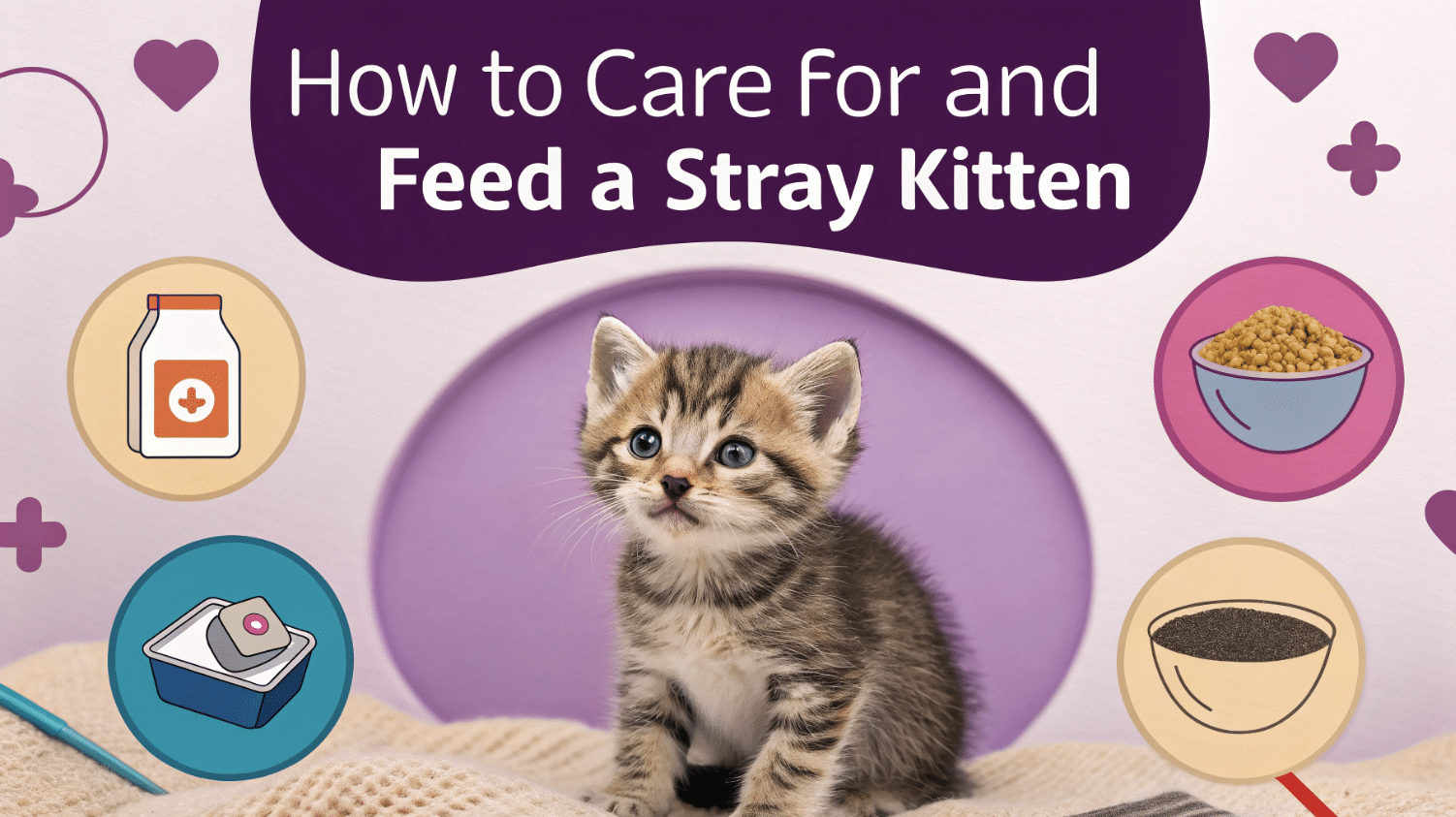
Finding abandoned kittens can be overwhelming, but with the right care, these tiny creatures can thrive. The first step is to ensure their survival by addressing their immediate needs, especially their need for food. Knowing how to feed abandoned kittens properly is crucial for their health.
They rely entirely on you for nourishment and warmth. A safe, cozy environment helps them feel secure and prevents life-threatening conditions like hypothermia. Every small effort you make can mean the difference between life and death for these vulnerable little ones.
Creating a Safe and Warm Environment for Abandoned Kittens
When you find a stray kitten, the first thing you need to do is create a nurturing environment. A warm and secure space is essential for their survival. Without warmth, kittens can’t regulate their body temperature, which puts them at risk of hypothermia. This can slow down their bodily functions, making it hard for them to eat or even survive. In the next section, you will learn how to provide the comfort and care they need.
Why Warmth is Essential for Orphaned Kittens
Newborn kittens, especially those under three weeks old, cannot generate enough body heat on their own. In the wild, they rely on their mother and siblings to stay warm. Without this natural source of heat, they chill quickly. Hypothermia is one of the biggest threats to their health.
If a kitten gets too cold, it won’t eat, and its digestive system will stop functioning properly.
Keeping them warm isn’t just about comfort—it’s about survival.
How to Set Up a Cozy Nest
Creating a cozy nest for the kitten is simple but crucial. This space will serve as their safe haven while they recover and grow.
Choosing the Right Bedding Materials
Start by selecting soft, insulating materials. Fleece blankets, towels, or even old T-shirts work well. Avoid anything with loose threads or holes that could trap tiny claws. Layer the bedding to create a soft, cushioned surface. This helps mimic the warmth and comfort of a mother cat’s fur.
Maintaining a Consistent Temperature
Kittens thrive in an environment that stays between 85°F and 90°F during their first week of life. Use a thermometer to monitor the temperature in their nest. If the room is too cold, you’ll need to add a heat source.
However, make sure the kitten has a cooler area to move to if they get too warm. Overheating can be just as dangerous as being too cold.
Tools You Need to Keep the Kitten Comfortable
Having the right tools on hand makes it easier to maintain a nurturing environment for the kitten. These items will help you keep them warm and secure.
Heating Pads or Warm Water Bottles
A heating pad designed for pets is a great option. Place it under one side of the bedding so the kitten can move away if they feel too hot. If you don’t have a heating pad, a warm water bottle wrapped in a towel works as a temporary solution.
Never place the kitten directly on a heat source, as this can cause burns.
A Quiet, Secure Space Away from Noise and Pets
Choose a quiet corner of your home where the kitten will be undisturbed by loud noises or other pets. A small box or laundry basket lined with bedding can serve as their nest. Cover the top with a light blanket to create a den-like atmosphere.
This helps the kitten feel safe and reduces stress.
By focusing on warmth and security, you’re giving the kitten the best chance to thrive. A nurturing environment not only keeps them physically healthy but also helps them feel loved and cared for.
How to Feed Abandoned Kittens
Feeding a stray kitten can feel overwhelming at first, but with the right approach, you can ensure they get the nutrition they need to grow strong and healthy. This section will guide you through what to feed, how to feed, and when to feed the kittens, so you can confidently care for your tiny new friend.
What to Feed a Stray Kitten
Knowing what to feed abandoned kittens is crucial for their survival. Their tiny bodies require specific nutrients that can only be provided by certain foods.
Kitten Formula vs. Cow’s Milk (Why Cow’s Milk is Harmful)
You might think cow’s milk is a good option for feeding the kittens, but it’s not. Cow’s milk lacks the essential nutrients kittens need and can upset their delicate stomachs, leading to diarrhea and dehydration. Instead, you should use a kitten formula, which is specially designed to meet their nutritional needs.
There are several excellent options available:
-
PetAg KMR Kitten Milk Replacer Powder: This is one of the best overall choices. It’s fortified with calcium, taurine, lysine, and linoleic acid to support healthy growth.
-
Hartz Kitten Milk Replacer: A budget-friendly option that still provides essential nutrients like taurine and calcium.
-
Nutri-Vet Milk Replacement: Easy to mix and contains probiotics to support digestion.
These products are widely available online or at pet stores. Always follow the instructions on the packaging to prepare the formula correctly.
Recommended Kitten Milk Replacers
If you’re unsure which brand to choose, stick with trusted commercial kitten milk replacers like KMR or PetAg KMR. These are specifically formulated to mimic a mother cat’s milk and provide the right balance of protein, fat, and carbohydrates.
Avoid homemade mixtures unless absolutely necessary, as they often lack the proper nutrients.
Step-by-Step Guide to Feeding Orphaned Kittens
Feeding a kitten isn’t just about giving them food—it’s about doing it safely and effectively. Follow this step-by-step guide to ensure you’re feeding the kittens the right way.
Using a Bottle or Syringe for Feeding
-
Choose the right tool: Use a kitten feeding bottle with a small nipple. If the kitten is too weak to suckle, a syringe without a needle works well.
-
Prepare the formula: Mix the kitten formula according to the instructions. Warm it to about 100°F, which feels slightly warm to the touch.
-
Test the flow: If using a bottle, make sure the milk drips slowly when you turn it upside down. A fast flow can cause choking.
-
Feed gently: Insert the nipple or syringe tip into the kitten’s mouth. Let them suckle at their own pace. Never squeeze the bottle or force-feed, as this can lead to aspiration.
Proper Feeding Posture to Prevent Choking
Always feed the kitten in a natural nursing position. Place them on their stomach with their head slightly raised, similar to how they would nurse from their mother. Avoid feeding them on their back, as this increases the risk of choking or milk entering their lungs.
Feeding Schedule for Abandoned Kittens
A consistent feeding schedule is vital for the kitten’s health. Their tiny stomachs can’t hold much, so they need frequent, small meals.
Newborn Kittens (Every 2-3 Hours)
Newborn kittens require feeding every 2-3 hours, even during the night. This frequent schedule ensures they get enough calories to grow and stay warm. Keep track of their feedings to avoid missing a meal.
Older Kittens (Gradual Reduction in Frequency)
As kittens grow, their feeding schedule changes. By 3-4 weeks old, you can start reducing the frequency to every 4-6 hours. At this stage, they may also begin showing interest in solid food, which you can introduce gradually.
Feeding abandoned kittens takes patience and care, but it’s incredibly rewarding. With the right kitten formula, proper feeding techniques, and a consistent schedule, you’ll give them the best chance at a healthy start in life.
Common Feeding Mistakes to Avoid
Feeding a stray kitten might seem straightforward, but small mistakes can lead to serious health issues. Understanding what to avoid ensures the kitten gets the best care possible. Let’s dive into two common errors and how you can prevent them.
Overfeeding or Underfeeding
Kittens have tiny stomachs, so feeding them the right amount is crucial. Overfeeding can cause digestive problems like diarrhea, which leads to dehydration. On the other hand, underfeeding deprives them of essential nutrients, slowing their growth and weakening their immune system.
Here’s how you can strike the right balance:
-
Follow feeding guidelines: Most kitten milk replacers, like PetAg KMR Kitten Milk Replacer Powder or Hartz Kitten Milk Replacer, include instructions for portion sizes based on the kitten’s age and weight. Stick to these recommendations.
-
Monitor their weight: Use a small kitchen scale to weigh the kitten daily. Healthy kittens should gain about 10-15 grams per day. If the weight doesn’t increase, adjust the feeding amount or consult a vet.
-
Feed smaller, frequent meals: For newborns, feed every 2-3 hours. As they grow, gradually reduce the frequency while increasing the portion size.
A simple table can help you keep track of feeding schedules and amounts:
|
Stick to this schedule to ensure the kitten gets enough nutrition without overloading their tiny stomach.
Feeding the Wrong Type of Milk
One of the most common mistakes is giving kittens cow’s milk. While it might seem like a natural choice, cow’s milk lacks the nutrients kittens need and often causes upset stomachs, diarrhea, and dehydration. This can quickly become life-threatening for a fragile kitten.
Instead, always use a kitten milk replacer. These formulas are specifically designed to mimic a mother cat’s milk, providing the ideal balance of protein, fat, and carbohydrates. Some excellent options include:
-
PetAg KMR Kitten Milk Replacer Powder: A top choice for its nutrient-rich formula, fortified with calcium and taurine.
-
Hartz Kitten Milk Replacer: A budget-friendly option that still delivers essential nutrients like lysine and linoleic acid.
-
Nutri-Vet Milk Replacement: Easy to mix and includes probiotics to support digestion.
If you can’t access a commercial kitten milk replacer immediately, you can use a temporary homemade solution. Mix one egg yolk with evaporated milk as an emergency option, but switch to a proper formula as soon as possible.
Key Tip: Always prepare the formula according to the package instructions. Using too much powder can make the milk too rich, while diluting it too much reduces its nutritional value.
Avoiding these common feeding mistakes ensures the kitten gets the nutrition they need to grow strong and healthy. With careful attention to portion sizes and the right type of milk, you’ll set them up for a thriving future.
Ensuring Hygiene and Health for Orphaned Kittens
Keeping orphaned kittens clean and healthy is just as important as providing them with food. Their tiny bodies are fragile, and they rely on you for everything, including hygiene and health monitoring. Let’s break down the steps to ensure you’re giving them the best care possible.
How to Stimulate Elimination
Newborn kittens can’t eliminate waste on their own. In the wild, their mother would lick their bellies and genital areas to help them urinate and defecate. Without this stimulation, waste can accumulate, leading to serious health issues.
Why Kittens Need Help with Elimination
Kittens under four weeks old lack the muscle control to urinate or defecate independently. If waste isn’t expelled regularly, it can cause discomfort, bloating, or even life-threatening infections. Helping them eliminate waste mimics what their mother would naturally do and keeps their digestive system functioning properly.
How to Gently Stimulate the Kitten Using a Damp Cloth
You can help the kitten eliminate waste by following these steps:
-
Prepare a soft cloth: Use a clean, damp cloth or cotton ball. Warm water works best, as it feels soothing and mimics the warmth of a mother cat’s tongue.
-
Position the kitten: Place the kitten on its belly, supporting its body with one hand. Avoid holding it upright or on its back.
-
Stimulate gently: Rub the cloth gently over the kitten’s lower belly and genital area in a circular motion. Continue until the kitten urinates or defecates.
-
Clean up afterward: Wipe the area clean with a fresh damp cloth to prevent irritation or infection.
Repeat this process after every feeding. Most kittens will need stimulation until they’re about four weeks old.
Cleaning and Grooming Abandoned Kittens
Orphaned kittens can’t groom themselves, so you’ll need to step in to keep them clean. Proper grooming not only keeps them comfortable but also prevents skin issues and infections.
How to Safely Clean a Kitten Without Bathing
Bathing a kitten can be risky, especially if it’s very young. Instead, spot-clean them using these steps:
-
Use a damp cloth: Gently wipe away any dirt, food residue, or waste from their fur. Focus on areas like their face, paws, and bottom.
-
Dry thoroughly: Pat the kitten dry with a soft towel. Wet fur can cause them to become cold, which is detrimental to their health.
-
Avoid harsh products: Never use soap, shampoo, or baby wipes, as these can irritate their sensitive skin.
Keep the cleaning process quick and gentle to avoid stressing the kitten.
Removing Fleas and Parasites
Fleas can quickly weaken a kitten by causing anemia, especially in newborns. Here’s how to safely remove fleas:
-
Use a flea comb: Comb through the kitten’s fur to catch fleas. Dip the comb in soapy water to kill the fleas.
-
Spot-treat with care: For kittens under eight weeks old, avoid chemical flea treatments. Instead, consult your vet for safe options.
-
Wash bedding: Clean the kitten’s bedding regularly in hot water to eliminate flea eggs and larvae.
If the infestation is severe, seek veterinary advice immediately.
Monitoring the Kitten’s Health
Regular health checks are crucial for the care of orphan kittens. Early detection of health issues can save their lives.
Signs of Illness to Watch For
Keep an eye out for these warning signs:
-
Lethargy: A kitten that’s unusually tired or unresponsive may be sick.
-
Poor appetite: Refusing to eat or drink can be a sign of an underlying health issue.
-
Diarrhea: Loose stools can lead to dehydration, which is dangerous for kittens.
-
Respiratory issues: Sneezing, coughing, or nasal discharge may signal an infection.
If you notice any of these symptoms, take prompt action to address the issue.
When to Take the Kitten to a Vet
Some situations require immediate veterinary attention. Take the kitten to a vet if:
-
It hasn’t gained weight in 24-48 hours.
-
It shows signs of dehydration, such as dry gums or sunken eyes.
-
It has difficulty breathing or persistent diarrhea.
A vet can provide treatments like fluids, medications, or nutritional support to help the kitten recover.
Caring for the kittens involves more than just feeding them. Hygiene and health monitoring play a huge role in their survival. Keeping them clean, aiding waste elimination, and monitoring for illness signs give cats the best chance to grow healthy and happy.
Caring for stray kittens may feel overwhelming at first, but following essential care instructions ensures their survival and growth. Begin by creating a warm and secure environment where they feel safe. Feed them properly with kitten milk replacers and maintain a consistent feeding schedule. Focus on hygiene by cleaning them gently and monitoring their health closely. Nurture their social skills through gentle handling and playtime.
If challenges arise, don’t hesitate to consult a veterinarian. Building a relationship with a vet is vital for vaccinations, deworming, and overall health. Stay patient and compassionate—your efforts make all the difference.

In her previous life, Lisa traveled extensively, both for work and leisure. After the pandemic struck, Lisa locked up her luggage and adopted a cat ever since.
Lisa is now an avid cat lover, she devotes most of her free time serving as butler to her adorable feline at home. When she is not with her cat, she can be seen using her phone sourcing for the latest cat supplies online.


